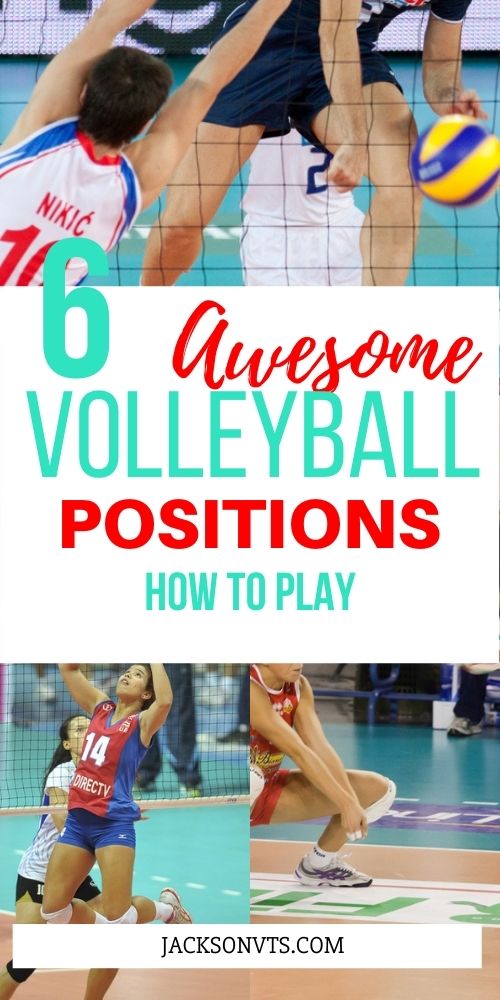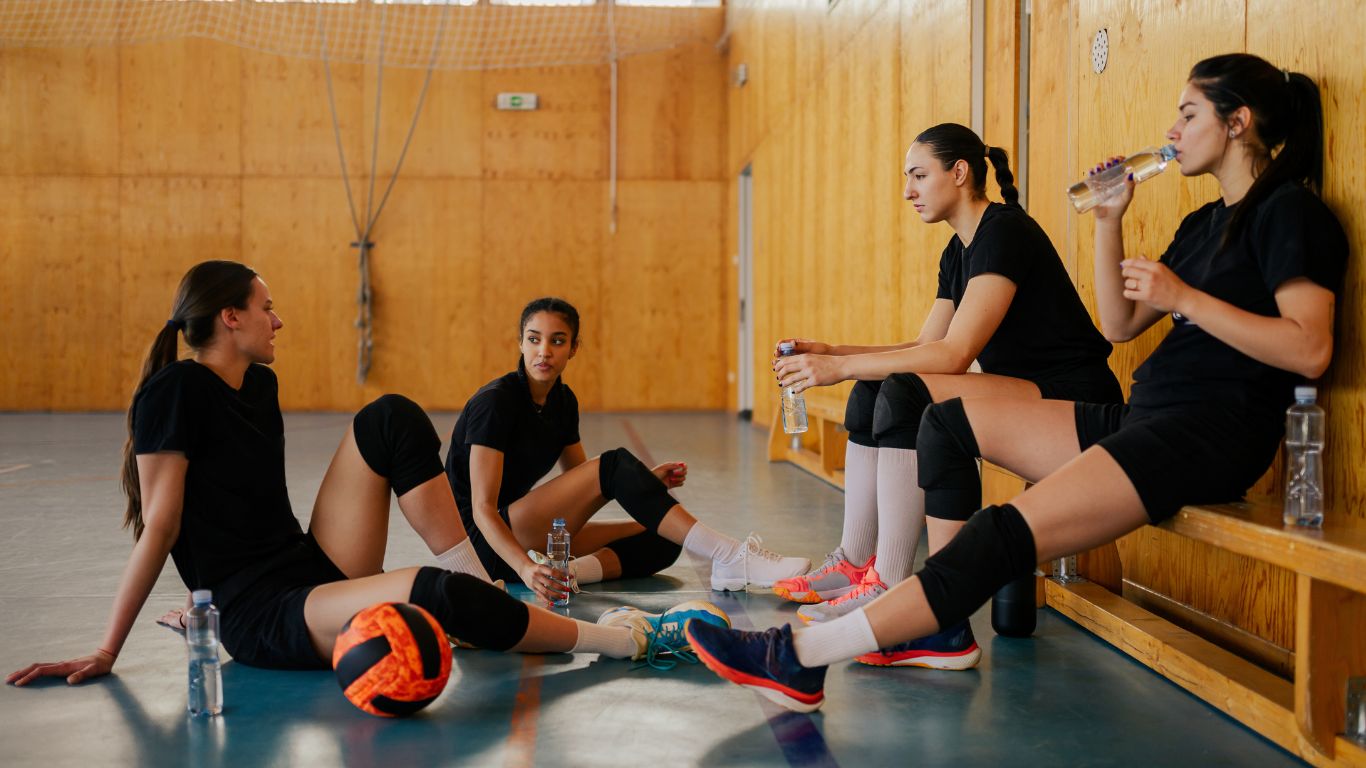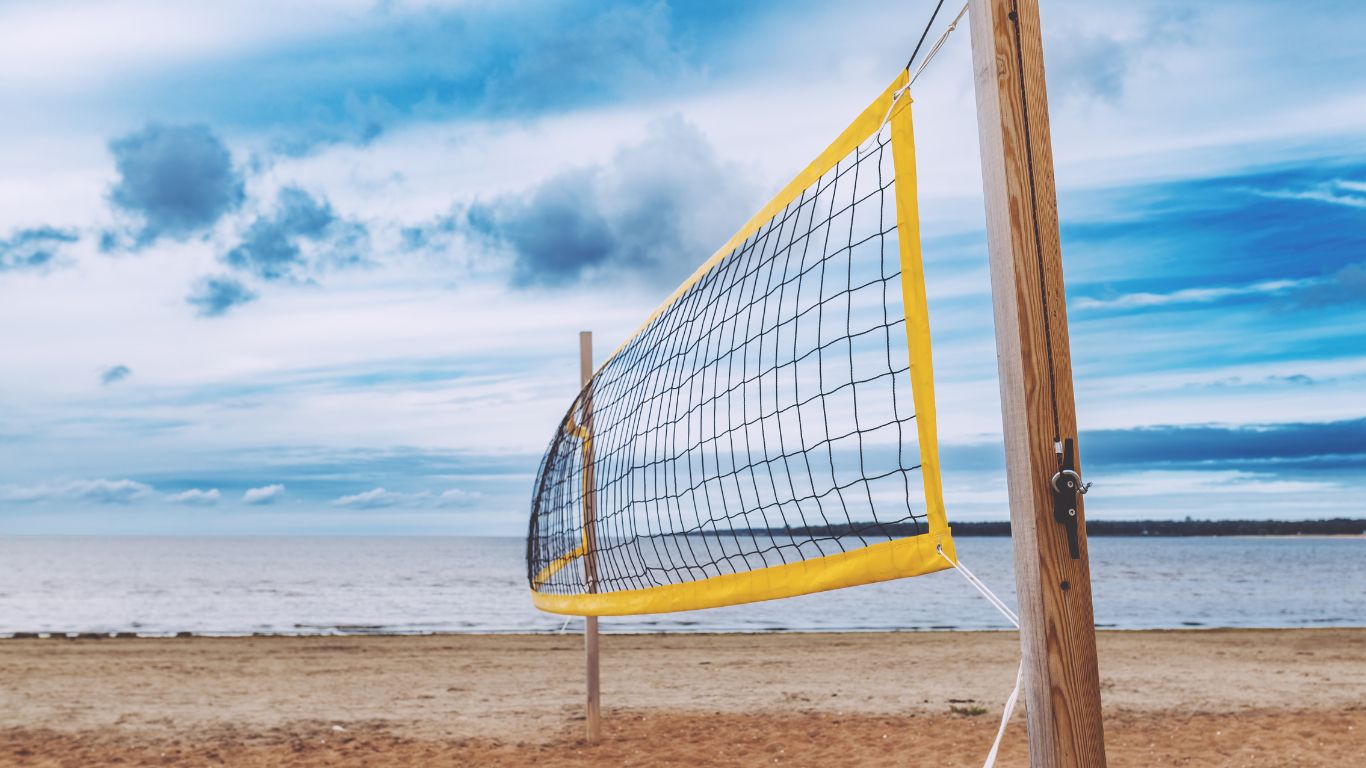A libero in volleyball is a specialized defensive player who wears a contrasting jersey and can replace any back-row player. The libero is not allowed to serve, rotate to the front row, or attack the ball above the net.
Volleyball, a popular sport played on both indoor and beach courts, features a unique position known as the libero. This player is easily recognizable by their contrasting jersey and plays a critical defensive role for the team. The libero is responsible for receiving serves, digging attacks, and making precise passes to facilitate efficient plays.
One key restriction is that the libero cannot serve, attack the ball above the net, or rotate to the front row. By specializing in defensive skills and offering increased stability, the libero helps enhance the team’s overall performance and success on the court.

Credit: www.jacksonvts.com
Overview Of Volleyball Positions
In the game of volleyball, each player on the team has a specific role and position to play. Understanding these positions is crucial to fully grasp the dynamics of the game and how each player contributes to the team’s success. Let’s take a closer look at the various positions in volleyball:
Setter
The setter is often considered the playmaker, responsible for setting up the team’s offensive plays. They possess great agility, quick reflexes, and excellent decision-making skills. The primary role of the setter is to receive the ball after the opponent’s serve, create accurate passes, and set up the attackers for a successful hit. Setters require exceptional hand-eye coordination and an ability to read the game, anticipating where the ball needs to be placed to maximize the team’s attack options.
Outside Hitter
The outside hitter, also known as the left-side hitter, plays a vital role in both offense and defense. This position demands a player who possesses versatility, power, and strong hitting abilities. Outside hitters typically receive sets from the setter and aim to score points by delivering powerful and accurate attacks from near the left antenna of the net. They are also expected to contribute to the team’s defense by blocking opposing hitters and making digs to keep the ball in play.
Middle Blocker
The middle blocker is a front-row player positioned near the net, often referred to as the ‘spiker.’ Their primary role is to block the opponent’s attacks and create obstacles for the opposing team’s hitters. Middle blockers need exceptional timing, agility, and height to successfully block the ball and disrupt the attacker’s rhythm. Additionally, they contribute to the team’s offense by executing quick attacks through the middle of the net, requiring effective coordination with the setter.
Opposite Hitter
The opposite hitter plays an essential role in completing the offensive lineup. Positioned opposite the setter, the opposite hitter is responsible for scoring points and creating powerful attacks from the right side of the net. They often face one-on-one situations against the opposing team’s outside hitter and are expected to excel in versatility, hitting prowess, and effective blocking capabilities. The opposite hitter helps maintain a balanced offense, keeping opponents guessing and the defense on their toes.
Understanding these key positions in volleyball provides insight into the intricacies of the game and the specialized roles each player fulfills. Each position demands unique skills and abilities, emphasizing the value of teamwork, coordination, and effective communication among teammates. Together, these positions create a cohesive unit, working towards a common goal of outplaying the opposing team and achieving victory.
What Is A Libero?
A libero is a specialized player in volleyball known for their exceptional defensive abilities and unique role on the court.
Definition
A libero is a player in volleyball who wears a different color jersey and has certain limitations on their actions during the game. They are primarily responsible for defensive plays, often substituting for back row players.
Specific Skills Required
- Quick reflexes: Liberos need rapid reactions to dig and receive powerful spikes from opponents.
- Excellent passing: They must be proficient at passing accurate balls to their teammates, ensuring efficient offensive plays.
- Agility and speed: Liberos require agility to move swiftly across the court and retrieve balls in a split second.
- Strategic positioning: They must have a keen understanding of the game and position themselves effectively to intercept incoming attacks.
Distinctive Uniform
Liberos are easily identifiable by their contrasting jersey color, often a different color from the rest of the team’s attire. This allows officials, teammates, and opponents to recognize the libero easily and enforce the specific rules related to their position.
The Role Of A Libero
Within the sport of volleyball, the libero position holds a crucial role in a team’s defensive strategy. As a specialized player, the libero serves as a defensive specialist, passing expert, and organizer of the backcourt. This article will delve into the responsibilities and skills that make the libero an integral part of any successful volleyball team.
Defensive Specialist
In volleyball, the libero acts as the team’s defensive specialist, primarily focusing on receiving serves and defending against opponents’ attacks. With excellent reflexes and anticipation, the libero quickly positions themselves to receive powerful serves and digs, keeping the ball in play.
Passing Expert
As a passing expert, the libero’s primary responsibility is to ensure accurate and consistent passes to their teammates. They possess exceptional ball control skills and use precise techniques to deliver controlled passes, enabling their teammates to set up successful attacks. The libero’s ability to pass consistently and effectively is instrumental in maintaining the team’s offensive flow.
Organizer Of The Backcourt
One of the most important roles of the libero is to organize the backcourt defense. They act as the anchor of the team’s defense, communicating and coordinating with other players to maximize defensive coverage. This includes calling out the direction of incoming attacks, assigning responsibilities for covering specific areas, and making split-second decisions to ensure the team’s defense remains strong.
To summarize, the libero is an invaluable asset to a volleyball team, contributing significantly to their defensive strategy. As a defensive specialist, passing expert, and organizer of the backcourt, the libero’s skills and abilities play a vital role in shaping the team’s overall success.

Credit: thesportjournal.org
Key Responsibilities
A libero in volleyball is a specialized defensive player responsible for receiving serves, digging the ball, and assisting with passing. They wear a different jersey color and have restricted offensive roles. The libero also acts as a leader on the court, providing crucial support for the team’s defensive strategies.
In the game of volleyball, the libero is a specialized defensive player who takes on key responsibilities to support their team’s success. As the libero plays a crucial role in the back row, they must excel in various areas to contribute effectively to their team’s overall performance.
Passing Serve
The libero’s primary responsibility is to excel in passing a serve. When the opposing team serves the ball, the libero must expertly receive it with precision and accuracy. Possessing exceptional passing skills allows the libero to set up their teammates for successful attacks and maintain control over the game.
Digging Attacks
Another key responsibility of the libero is to excel in digging attacks. When the opposing team attempts to spike the ball, the libero must be quick on their feet and ready to dig the powerful attacks. Their ability to anticipate and react swiftly enables them to keep the ball in play and prevent the opponents from scoring points.
Covering Tips And Short Balls
One crucial task for the libero is covering tips and short balls. When the opposing team decides to strategically tip the ball over the net or execute a short pass, the libero must be agile and ready to move quickly towards the intended landing spot. Their quick reflexes and court awareness allow them to cover these types of shots effectively, minimizing the chances of the opposition’s success.
In summary, the libero’s key responsibilities in volleyball involve passing serves, digging attacks, and covering tips and short balls. By excelling in these areas, the libero plays an essential role in their team’s defensive efforts, ultimately contributing to the overall success of the game.
Libero Rules
The Libero is a key player in volleyball, particularly in enforcing the Libero rules. Understanding these rules is essential for anyone interested in the game. Let’s delve into the specific regulations that govern the role of the Libero.
Restricted To Back Row
The Libero is exclusively confined to the back row, restricting their involvement in the front line. This means they are not allowed to execute any attack hits from the front zone or perform blocking actions at the net. Their primary responsibility lies in defense and serve reception. By maintaining this positional constraint, their role as a defensive specialist is precisely defined.
Limited Offensive Actions
In addition to staying within the back row, the Libero is also limited in carrying out certain offensive actions. They are not permitted to serve, attempt to block or attempt to spike above the height of the net. However, they can set the ball from any height provided the action takes place behind the 3-meter line. By enforcing these limitations, the Libero’s offensive contributions are efficient and strategically oriented.
No Rotational Substitutions
Unlike other players, the Libero is exempt from making rotational substitutions. As a result, they can freely substitute for any back-row player without prior rotation. This unique rule eliminates the need for adhering to specific rotation patterns and simplifies the substitution process. It allows teams to seamlessly reinforce their back-row defense without disruption.
Training And Development Of Liberos
The libero position in volleyball is crucial for enhancing the team’s defense by providing excellent passing and digging skills. To become a successful libero, training and development play a vital role. Various techniques, court awareness exercises, and communication practices are incorporated into the training regimen of liberos to enhance their performance. Let’s delve into each aspect in detail to understand the training and development of liberos.
Technique Drills
Technique drills are instrumental in honing the skills required for effective libero play. These drills focus on improving passing, digging, and serving techniques. Liberos undergo repetitive practice sessions to perfect their skillset.
Here are some example technique drills:
- Serve and Pass Drills: Liberos practice serving the ball and then quickly transitioning into a defensive position to receive the serve. This drill helps them work on their passing skills under pressure.
- Digging Drills: Liberos perform digging drills to learn how to anticipate and react swiftly to powerful spikes and challenging shots. These drills aim to improve their accuracy, technique, and reaction time.
- Footwork Drills: Liberos focus on footwork drills to enhance their agility and quickness on the court. These drills train them to move quickly between different defensive positions and better position themselves for passes or digs.
Court Awareness Exercises
Developing court awareness is essential for liberos to anticipate the opponents’ moves and make split-second decisions. Court awareness exercises enable liberos to effectively position themselves on the court and read the game situation accurately.
Here are some examples of court awareness exercises:
- Positioning Drills: Liberos practice positioning themselves in various defensive positions based on the game scenario. These drills improve their spatial awareness and help them understand where they need to be on the court at any given moment.
- Reaction Time Exercises: Liberos work on improving their reaction time by participating in drills where they have to quickly respond to simulated game situations. These exercises enhance their ability to anticipate and read the opponents’ hits accurately.
- Visual Tracking Drills: Liberos engage in drills that involve closely following the trajectory of the ball from the moment it leaves the opponent’s hand. This improves their ability to anticipate the direction and speed of the ball, helping them to position themselves effectively.
Communication Practice
Effective communication is vital for the libero position as they serve as the defensive anchor of the team. Clear and concise communication helps liberos coordinate with their teammates, provide instructions, and make split-second decisions during the game.
Here are some methods used for communication practice:
- Verbal Communication: Liberos practice verbal communication by calling out the ball’s location, communicating with teammates to indicate who should take the ball, and providing instructions during defensive plays. Clear and concise communication ensures smooth coordination within the team.
- Hand Signals: Liberos use hand signals to communicate with their teammates effectively. These signals often indicate the direction the libero intends to pass the ball or provide instructions on defensive positioning.
- Eye Contact: Maintaining eye contact with teammates allows liberos to communicate non-verbally, especially during loud game situations when verbal communication may be challenging. Eye contact signals intent and helps in decision-making.
By incorporating technique drills, court awareness exercises, and communication practice into their training, liberos build a solid foundation of skills. This enables them to excel in their position and contribute significantly to the success of the team.
Famous Liberos In Volleyball History
A Libero in volleyball is a specialized defensive player who wears a different colored jersey. They excel in digging and passing the ball, often making crucial saves. Some famous Liberos in volleyball history include Brenda Castillo and Fabi Oliveira.
Famous Liberos in Volleyball History Volleyball has seen some incredible liberos throughout its history. These specialized defensive players have made a significant impact on the game, using their exceptional skills to keep the ball off the ground and control the flow of the game. Let’s take a closer look at three famous liberos who have left their mark on the sport.
Sergio Santos
Sergio Santos is hailed as one of the best liberos in volleyball history. This Brazilian player showcased exceptional defensive abilities that astonished both opponents and spectators. His agility and quick reflexes allowed him to dig even the most powerful spikes, making him an integral part of the Brazilian national team’s success. Santos’ ability to read the game and position himself perfectly on the court made him a force to be reckoned with.
Fabio Ricci
Fabio Ricci, an Italian libero, has left an indelible impact on the volleyball world. Known for his extraordinary anticipation and impeccable ball control, Ricci has consistently delivered exceptional performances throughout his career. His defensive skills have earned him numerous accolades, and he has become a role model for aspiring liberos around the globe. With determination and passion, Ricci has become a symbol of excellence in the sport.
Takeshi Nagano
Takeshi Nagano, a Japanese libero, is widely regarded as a trailblazer in the position. His ability to read the game and anticipate the opponent’s moves set him apart from his peers. Nagano’s exceptional digging and passing skills allowed him to provide a strong defensive foundation for his team. Moreover, his leadership qualities and calm presence on the court earned him the respect of his teammates and opponents alike. Nagano’s contributions to the sport continue to inspire aspiring liberos worldwide. These three legendary liberos have revolutionized the game of volleyball with their extraordinary skills and dedication. They have set high standards for future generations to follow, showcasing the immense potential of the libero position. As we celebrate their achievements, we are reminded of the crucial role these players play in the success of their teams.

Credit: www.ncaa.com
Importance Of The Libero In A Team
Enhanced Defensive Efficiency
The libero position in volleyball is crucial in enhancing defensive efficiency on the court. Liberos are equipped with exceptional defensive skills and agility, allowing them to swiftly react to opposition attacks while providing stability to the back-row defense. Their presence enables the team to counter aggressive spikes and powerful serves, ultimately strengthening the overall defensive capabilities.
Greater Precision In Play
Liberos contribute to greater precision in play through their exceptional ball-handling and passing abilities. Their specialized training enables them to perform accurate receives, setting up perfect plays for their teammates. By seamlessly controlling the tempo of the game and executing precise passes, liberos play a significant role in maintaining the flow of the game and enabling their team to capitalize on strategic opportunities.
Tactical Advantage
Having a libero on the team provides a tactical advantage that significantly impacts the team’s overall performance. Liberos can anticipate opponent plays, making strategic movements to nullify attacking attempts. Their strategic proficiency and court awareness elevate the team’s gameplay by effectively countering the opposition’s tactics, ultimately providing a competitive edge during crucial match situations.
Different Strategies Involving The Libero
In the game of volleyball, the libero is a specialized defensive player who plays a crucial role in a team’s success. While the primary responsibility of a libero is to excel in their defensive skills, they also contribute strategically to the overall gameplay. In this article, we will explore three different strategies involving the libero: libero substitution strategy, double libero strategy, and libero setting strategy.
Libero Substitution Strategy
The libero substitution strategy is a popular tactic employed by many teams to maximize the libero’s impact on the game. In this strategy, the libero enters the game specifically to replace a back-row player when they rotate to the front row. By doing so, the team can ensure that their strongest defensive player is always on the court, enhancing their chances of winning crucial defensive points.
To execute the libero substitution strategy effectively, teams must carefully analyze the opposing team’s rotations and plan their player substitutions accordingly. This allows them to maintain a strong defensive presence throughout the match, even when certain players are rotated out of the back row. By utilizing this strategy, teams can exploit the libero’s exceptional defensive skills without compromising the team’s overall gameplay.
Double Libero Strategy
Another intriguing strategy involving the libero is the double libero strategy, where teams opt to have two liberos on the court simultaneously. This tactic is typically utilized when a team possesses two exceptional defensive players who excel in different areas of the game. By having two liberos, teams can cover a larger defensive area, making it more challenging for the opponent to find open spaces to score.
The double libero strategy requires careful coordination and communication between the liberos, as they need to efficiently divide the defensive responsibility and ensure that there are no gaps in coverage. This strategy can be highly effective in neutralizing powerful offensive players and increasing the team’s overall defensive capabilities.
Libero Setting Strategy
In addition to their defensive prowess, some liberos possess excellent setting skills, allowing them to contribute to the team’s offense as well. The libero setting strategy involves utilizing the libero’s setting abilities to surprise the opponent and create scoring opportunities for their spikers.
By incorporating the libero into the team’s setting strategy, teams can introduce an element of unpredictability and confusion in the opponent’s defense. The libero’s ability to set the ball accurately opens up various attacking options, creating a more versatile and dynamic offense. This strategy can catch the opponent off guard and tilt the momentum in favor of the team employing it.
To conclude, the libero in volleyball is not just a defensive player but also a strategic asset for any team. By using the libero substitution strategy, double libero strategy, and libero setting strategy, teams can optimize the libero’s unique skills and greatly enhance their chances of winning matches. Understanding and implementing these different strategies involving the libero can be a game-changer for any volleyball team.
Challenges Faced By Liberos
In the fast-paced game of volleyball, the role of a libero is crucial in ensuring successful defense and a strong offensive play. As the key defensive player, liberos face unique challenges that require a high level of skill, quick reactions, and mental toughness. Let’s dive into some of the main challenges that liberos encounter on the volleyball court.
Body Positioning
Liberos must maintain proper body positioning to execute effective defensive plays. They need to be agile and have excellent footwork to quickly position themselves in the best spot to receive hard-driven hits from the opposing team. It is crucial for liberos to anticipate the trajectory of the ball and adjust their body alignment accordingly. This requires the ability to react swiftly while maintaining balance and ensuring optimal body control.
Quick Reactions
The ability to react quickly is an essential attribute for any libero. They need to constantly be on high alert, ready to respond instantly to unexpected shots from the opponent. Liberos must possess excellent reflexes and hand-eye coordination to dig low, powerful serves or react to sudden changes in the ball’s direction. Their quick reactions play a vital role in preventing the opponent’s attacks from hitting the ground, keeping their team in the game.
Mental Toughness
Liberos face immense pressure during intense volleyball matches. They are often targeted by the opposing team, as their role is crucial in disrupting the opponent’s offensive strategies. Mental toughness is essential for liberos to remain composed and focused amidst the high-stakes environment. They need to handle criticisms, adapt to changing game situations, and maintain their confidence even when faced with setbacks. Liberos must possess a strong mindset to consistently perform at their best and lead their team to victory.
Qualities Of An Exceptional Libero
In volleyball, the libero plays a pivotal role in the team, specializing in defensive skills and providing crucial support in passing and serve-receive. An exceptional libero possesses a combination of specific qualities that set them apart on the court. Let’s explore the key attributes that define a standout libero.
Passing Accuracy
The exceptional libero demonstrates outstanding passing accuracy, excelling in maintaining a steady flow of precise passes to the setter or hitter. Their ability to consistently deliver accurate receptions under pressure is a primary factor in initiating successful offensive plays.
Defensive Prowess
Beyond passing, an exceptional libero exhibits remarkable defensive prowess, showcasing exceptional reflexes, agility, and anticipation to effectively dig out hard-driven attacks and expertly control the ball, preventing it from hitting the floor.
Leadership Skills
Moreover, leadership skills are a defining trait of an exceptional libero. They serve as the on-court communication hub, organizing the defensive alignment, guiding teammates, and fostering a unified and supportive team dynamic through their vocal and assertive communication.
Evolution Of The Libero Position
A Libero in volleyball is a specialized defensive player who wears a different colored jersey. This position has evolved over the years to provide teams with exceptional defensive skills and strategic positioning on the court.
Introduction And Adoption
The evolution of the libero position in volleyball has had a profound impact on the game. Initially introduced in the late 1990s, the libero position was designed to serve as a defensive specialist, replacing one of the back-row players. This new role brought a fresh dynamic to the game, allowing teams to have a highly skilled defensive player without sacrificing any offensive firepower.
Adopting the libero position was a significant change for the sport, and it didn’t take long for teams to recognize the advantages it offered. The International Volleyball Federation (FIVB) officially implemented the libero position in 1998, and it was quickly embraced by teams around the world.
Impact On Modern Volleyball
The adoption of the libero position has revolutionized the game of volleyball in several ways. Here are a few key ways in which this specialized role has made an impact:
- Enhanced Defensive Abilities: The libero’s primary responsibility is to excel in defensive skills, such as digging and receiving serves. With their specialized training and focus, liberos can often make spectacular saves that were previously impossible for traditional back-row players.
- Improved Team Coordination: With the libero on the court, teams have an extra player dedicated solely to defensive duties. This allows other players to focus more on their offensive roles, resulting in improved overall team coordination and efficiency.
- Strategic Substitutions: The libero’s unique ability to enter and exit the game without counting towards the team’s standard substitution limit gives coaches more flexibility in managing their lineups. This strategic advantage allows players to be rested or specialized substitutions to be made without penalty.
- Expanded Offensive Opportunities: By allowing a player to specialize in defensive skills, the libero position has opened up new offensive possibilities for teams. With the libero frequently handling first-ball receptions, setters have more options for distributing the ball, leading to varied and unpredictable attacks.
The libero position has truly transformed modern volleyball, enhancing both defensive and offensive aspects of the game. It has brought new strategies and dimensions to the sport, making it more exciting and dynamic for players and fans alike.
Role Of The Libero In International Competitions
In international volleyball competitions, such as the Olympic Games, World Championships, and Continental Tournaments, the libero plays a crucial role in the team’s success. The libero is a defensive specialist who wears a contrasting jersey color and has certain unique responsibilities on the court. Let’s delve into the important role of the libero in the most prestigious international volleyball competitions.
Olympic Games
The Olympic Games is the pinnacle of sports, and volleyball is among the most highly anticipated events. In Olympic volleyball matches, the libero’s role takes center stage as they enhance the team’s defensive capabilities. The libero acts as a defensive anchor, adept at digging spikes, receiving powerful serves, and setting up the attackers. Their primary objective is to keep the ball in play, preventing the opposing team from gaining an advantage through powerful hits and precise serves.
World Championships
The World Championships bring together the best teams from around the globe to battle for the ultimate title. In this prestigious tournament, the libero’s skills are put to the test as they face off against the most formidable opponents. The libero’s exceptional digging and ball control skills make them instrumental in the team’s overall performance. Their ability to quickly retrieve hard-hit balls and distribute them accurately to the attackers sets the tone for successful offensive plays.
Continental Tournaments
Continental Tournaments, such as the European Championship and Asian Games, showcase the strength and talent of regional volleyball teams. The libero’s role in these competitions is no less vital than in other international events. The libero’s expertise in reading the game, anticipating the opponent’s moves, and making quick decisions significantly improves the team’s defensive stance. By consistently providing accurate passes, they allow the setters and attackers to execute their strategies flawlessly.
Frequently Asked Questions
What Is Role Of Libero In Volleyball?
The libero in volleyball is a defensive specialist, wearing a different color jersey, and has specific rules to substitute and play in the back row, enhancing team defense and ball control.
Why Is The Libero Not Allowed To Serve?
The libero is not allowed to serve because they are a specialized defensive player. Serving requires players to rotate and play all positions, which goes against the libero’s role of providing consistent defensive support.
Can A Libero Hit?
A libero cannot hit the ball over the net while in front of the ten-foot line.
Why Does The Libero Wear A Different Color?
The libero wears a different color to distinguish them as defensive specialists. This helps the referees and players identify them easily.
Conclusion
The libero in volleyball plays a crucial role in defense and passing, making them an invaluable asset to the team. Their unique position and specific rules set them apart, allowing for strategic plays and game-changing contributions. Understanding the libero’s role is essential for any volleyball enthusiast, as it adds depth and appreciation to the sport.









